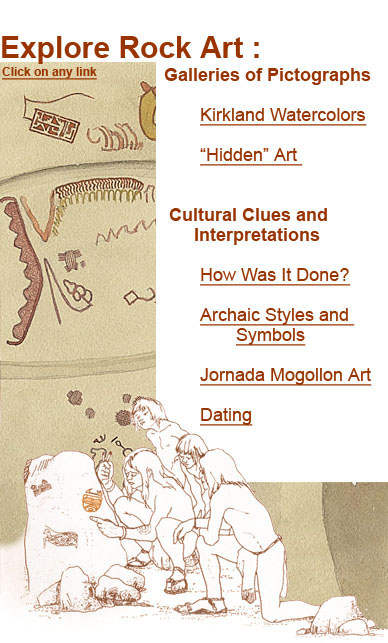Legacy on the Rocks: The Art of Hueco Tanks
|
The rocks and shelters of Hueco Tanks hold one of the most remarkable collections of pictographs in North America. Unlike the massive painted panels that loom from canyon walls in the Lower Pecos region of Texas or the desert canyons of the greater American Southwest, much of the art of Hueco Tanks is distinctive for its diminutive size, variety of styles, and—in many cases—almost secretive locations. Researchers and TPWD staff estimate there may be as many as 5000 painted symbols on the rocks. Continued survey and new techniques in photography are revealing even more artwork hidden within the jumbled rock hills. Although no one is certain of the age of the earliest cultural expression at Hueco Tanks, there is a long tradition of painting there. The presence of water and other vital natural resources may have served as inspiration for the painters; some, perhaps, even executed their work during rituals or ceremonies. Who were the artists who left these enigmatic and haunting displays? What cultural influences can be identified in the styles and symbols? When were they painted? Answers to these and other questions are not easy to come by, nor likely will they ever be, although new techniques are adding important information to the discussion. Most scholars believe that Archaic hunter-gatherers left their mark in what might be considered more traditional panels, that is, in paintings of recognizable beings such as deer and other animals. They also created panels of geometric patterns and lines. It is the work of later Jornada Mogollon artists, however, that sets Hueco Tanks apart from most other sites and has spawned more controversial interpretations. Researchers see a variety of cultural influences and meanings in the array of small mask-like visages, expressive faces, and goggled-eyed symbols left by this farming/foraging culture of the Formative period. |
|
In these sections, we offer galleries of some of Hueco Tanks' rock art treasures, examine the different interpretive viewpoints, and present some of the newest discoveries. Included are the watercolor paintings of the pictographs executed by renowned artist Forrest Kirkland in the 1930s as well as the modern photography by Robert Mark and Evelyn Billo of Rupestrian Cyberservices. Both resources are critical: Kirkland's work shows much of the art in an earlier stage before natural and human forces conspired in their destruction. Also included are Kirkland's observations on the content and condition of the paintings at the time of his recording. It should be noted that, when pictographs were faded or obscured by graffiti, Kirkland at times attempted to "complete" the missing sections by extrapolating. Although some researchers today take issue with some of his interpretations and terminology, such as the use of the word "mask" to describe the visages, Kirkland's notes contain valuable insights and information not available otherwise. The Gallery of Rupestrian photos captures not only the art today, in its present state (some have been cleaned of graffiti), but many other depictions that had either faded from view or previously not been recognized. Aside from their technical quality, the photos provide a feel for how the art was situated in the various shelters and overhangs, and how the artists often took advantage of natural features such as hollows and cracks in the rock. The photographers' techniques used in capturing and revealing "hidden" art also are discussed. |

